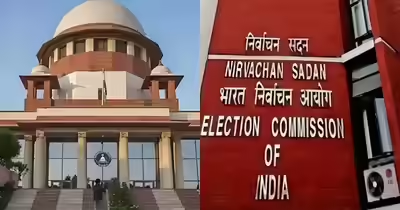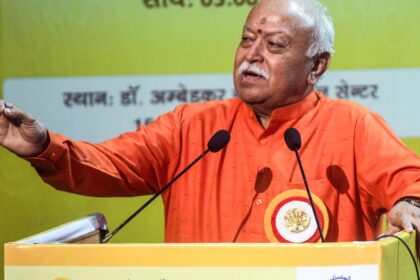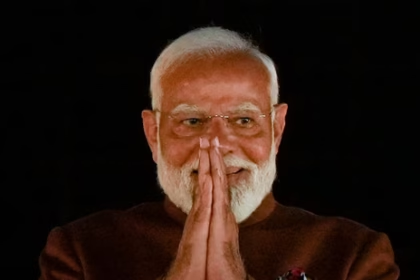Aadhaar, Voter ID, Ration Cards Not Valid as Proof for SIR: Election Commission Clarifies
Aadhaar, issued by the Unique Identification Authority of India (UIDAI), was designed as a biometric identity number aimed at improving welfare distribution and minimizing duplication in beneficiary databases. However, the Aadhaar Act clearly states that it is not a document of citizenship. It verifies identity and residence, not nationality. Courts have reiterated this in multiple rulings, emphasizing that Aadhaar alone cannot be considered evidence of Indian citizenship.
The Voter ID or EPIC (Electors Photo Identity Card), issued by the EC itself, serves primarily as a proof of eligibility to vote. While it implies a degree of vetting during the electoral roll process, it is not immune to errors, duplicate entries, or fraudulent inclusions. Therefore, its reliability as sole proof of citizenship is questionable.
Ration Cards, on the other hand, are distributed under the Public Distribution System (PDS) to ensure food security to economically weaker sections. They are issued at the state level, often based on self-declarations and minimal scrutiny, making them susceptible to irregularities. As a result, their legal value in establishing citizenship is weak at best.
Together, these documents reflect administrative acknowledgment of a person’s existence within government databases, but they fall short of confirming a person’s constitutional or legal nationality. This clarification is vital for policy implementation, legal proceedings, and citizen rights.
In a move that has stirred national attention, the Election Commission (EC) of India recently clarified that documents such as Aadhaar, Voter ID, and Ration Cards cannot be used as conclusive proof for establishing citizenship under the Standard Operating Procedure for Suspected Illegal Residents (SIR). This clarification has raised questions about document validity, identity verification norms, and the legal scope of India’s most commonly used public identity instruments.
The announcement came amid ongoing debates and legal proceedings involving citizenship verification mechanisms, especially in sensitive border states and under the proposed framework of the National Register of Citizens (NRC). While Aadhaar, Voter ID, and Ration Cards are widely used for accessing government schemes, subsidies, and voting rights, the EC has drawn a clear distinction between these identity proofs and documents that can affirm one’s nationality.
This demarcation is critical in the context of rising anxieties over demographic identification, particularly in areas witnessing migration, border security issues, or political tension related to community-based citizenship. The EC’s stance underscores the need to revisit assumptions about what these documents represent and why a legally secure and accurate framework for verifying citizenship is essential in a democracy.
Part 2: Understanding the Role and Limitations of Aadhaar, Voter ID, and Ration Cards
To understand the gravity of the EC’s clarification, it is essential to dissect the legal purpose, scope, and limitations of Aadhaar, Voter ID, and Ration Cards. Each of these documents serves a unique administrative function but lacks the foundational legal backing required to establish citizenship.
Aadhaar, issued by the Unique Identification Authority of India (UIDAI), was designed as a biometric identity number aimed at improving welfare distribution and minimizing duplication in beneficiary databases. However, the Aadhaar Act clearly states that it is not a document of citizenship. It verifies identity and residence, not nationality. Courts have reiterated this in multiple rulings, emphasizing that Aadhaar alone cannot be considered evidence of Indian citizenship.
The Voter ID or EPIC (Electors Photo Identity Card), issued by the EC itself, serves primarily as a proof of eligibility to vote. While it implies a degree of vetting during the electoral roll process, it is not immune to errors, duplicate entries, or fraudulent inclusions. Therefore, its reliability as sole proof of citizenship is questionable.
Ration Cards, on the other hand, are distributed under the Public Distribution System (PDS) to ensure food security to economically weaker sections. They are issued at the state level, often based on self-declarations and minimal scrutiny, making them susceptible to irregularities. As a result, their legal value in establishing citizenship is weak at best.
Together, these documents reflect administrative acknowledgment of a person’s existence within government databases, but they fall short of confirming a person’s constitutional or legal nationality. This clarification is vital for policy implementation, legal proceedings, and citizen rights.
The Election Commission’s statement carries significant legal weight in the broader framework of India’s constitutional machinery. Citizenship, as defined under the Citizenship Act of 1955, is a matter of legal entitlement — not administrative convenience. The EC’s refusal to treat Aadhaar, Voter ID, and Ration Cards as proof of citizenship reaffirms the constitutional boundaries that distinguish between being a resident and being a citizen.
At the heart of this clarification lies a profound legal implication: not all forms of state-issued identification confer nationality. In a country like India, where identity documents are often used interchangeably in everyday life — from accessing rations to applying for jobs, voting, or availing subsidies — the distinction is easily blurred. However, under constitutional scrutiny, each of these documents must withstand a higher burden of proof if they are to be treated as legal evidence of citizenship.
Legal experts argue that this clarification also shields the Election Commission from future litigations, particularly in areas where political tensions surround the issue of “suspected illegal residents.” By establishing that none of these identity documents can automatically confer or confirm citizenship, the EC distances itself from potential misuse or overreach in citizenship-related disputes, particularly under the NRC framework or in border-state documentation reviews.
Moreover, this stance is in line with several Supreme Court observations. In cases such as Binoy Viswam v. Union of India and Justice K.S. Puttaswamy v. Union of India, the apex court has laid down foundational principles regarding the scope of Aadhaar and other identity documents, repeatedly affirming that identity verification and citizenship proof are legally and functionally distinct.
This differentiation also resonates with India’s obligations under international law. As a signatory to various human rights conventions, India must ensure that the legal status of individuals — including migrants, refugees, and stateless persons — is determined through transparent and constitutionally sound mechanisms. The Election Commission’s clarification, therefore, contributes toward upholding procedural integrity and protecting due process under the law.
The Election Commission’s clarification has prompted a wide spectrum of political and public reactions, reflecting the deeply entrenched debates surrounding citizenship and identity in India. Political parties across the ideological divide have interpreted the move in ways that align with their broader positions on migration, national security, and constitutional rights.
Leaders from the ruling establishment have largely welcomed the EC’s clarification, viewing it as a necessary step to prevent misuse of documents and ensure that the citizenship verification process remains legally robust and politically neutral. Some members of Parliament have even argued that the clarification should lead to more comprehensive and centralized citizenship documentation, akin to the now-stalled National Population Register (NPR).
In contrast, opposition parties and civil society groups have raised concerns that the clarification could be used to exclude legitimate citizens, particularly marginalized communities that may lack access to high-quality documentary proof of ancestry or residence. Critics argue that this move, if not carefully handled, could intensify fears surrounding the NRC and Citizenship Amendment Act (CAA), especially among Muslim and tribal populations.
Several human rights organizations have also voiced their apprehension. They contend that the EC’s clarification, while legally valid, risks being interpreted as a tool for exclusion rather than transparency unless accompanied by safeguards and community outreach. They have urged the government to ensure that no one is disenfranchised or denied benefits due to the inability to produce alternative documents.
On social media and in civic spaces, public discourse has been charged, with hashtags like #CitizenshipProof and #IdentityDebate trending across platforms. Journalists, legal experts, and activists are engaging in live discussions and panels to unpack the ramifications of the EC’s announcement.
The diversity of responses highlights the importance of public communication and legal literacy. If the Election Commission aims to maintain public trust, it must engage more proactively with stakeholders, disseminate clear guidelines, and collaborate with state agencies to ensure the clarification is not misused or misunderstood.
Ultimately, the clarification opens a vital national conversation about who gets to claim citizenship and what kind of evidence is deemed acceptable by the state. The reactions it has triggered serve as a reminder that identity is not just an administrative matter — it is a deeply human one, woven into the socio-political fabric of the nation.
As the debate around Aadhaar, Voter ID, and Ration Cards intensifies following the Election Commission’s clarification, the real-world impact on ordinary citizens is becoming increasingly apparent. For millions of Indians—especially those belonging to marginalized, tribal, migrant, or economically weaker communities—this legal and administrative distinction between identity and citizenship isn’t just theoretical. It directly affects their access to rights, recognition, and a sense of belonging.
In states like Assam, West Bengal, Jharkhand, and parts of Uttar Pradesh and Bihar, many citizens depend on documents like Aadhaar and ration cards to access food subsidies, employment schemes, school admissions, pensions, and healthcare. These are not merely conveniences—they are lifelines. For families whose survival depends on public welfare schemes, the threat that these documents may not validate their citizenship can result in immense insecurity.
Take, for example, the case of daily-wage workers or seasonal migrants. These individuals often move across state lines in search of employment and live without consistent access to housing or documentation. They may possess ration cards from their native village, an Aadhaar address from a rented urban dwelling, and possibly no voter ID due to relocation or bureaucratic delays. Under the EC’s clarified standard, none of these documents could help prove their citizenship in a legal proceeding—a scenario that could prove catastrophic if their citizenship is ever questioned under frameworks like the NRC.
Women, in particular, face an additional burden. In rural India, women are often registered under their husband’s or father’s name in most official documents. If questioned, they may be unable to produce individualized documents that demonstrate both identity and legal ancestry—making them disproportionately vulnerable in any future verification drive.
This reality becomes even starker for those affected by natural calamities or displacement. Floods, communal riots, or demolitions have led many to lose their documents entirely. In such cases, rebuilding a citizenship claim without Aadhaar, Voter ID, or ration card would be an uphill, if not impossible, battle.
Moreover, the psychological cost of living under a cloud of doubt regarding one’s citizenship cannot be understated. In communities where NRC exercises have already created panic, the EC’s clarification acts like a double-edged sword—it may close one legal loophole but leaves many without a clear path forward. Families that have lived in India for generations now worry that they may one day be required to produce documentation they never thought they needed to keep or never had access to in the first place.
Activists and legal aid workers across the country are stepping up to provide support, offering assistance in document compilation, ancestry tracing, and legal counselling. But the infrastructure to support such a massive undertaking is still rudimentary, underfunded, and stretched thin. Legal literacy campaigns, awareness drives, and citizen helplines are crucial but inconsistent, especially in rural and remote areas.
In many ways, the EC’s clarification brings to the fore a deeper and long-standing issue within Indian governance: the mismatch between administrative documentation and constitutional entitlement. The reliance on documents created for service delivery as de facto proof of citizenship reveals systemic weaknesses in India’s civil registration systems.
Ultimately, this situation calls for a human-centric approach to documentation and identity. While legal precision is necessary, it must be balanced with compassion, flexibility, and safeguards to ensure that innocent citizens are not rendered stateless by technicalities. As India moves forward in clarifying what counts as proof of citizenship, it must also invest in ensuring that every legitimate citizen, regardless of social standing, has the opportunity and resources to secure and prove that identity. Only then can democracy remain inclusive, and justice truly accessible.
The Election Commission’s clarification, while constitutionally aligned, presents a daunting challenge for India’s marginalized communities. For millions of people living in rural, tribal, and economically backward areas, the idea of proving citizenship through documentary evidence is fraught with systemic barriers. These populations often lack access to consistent documentation due to historical neglect, illiteracy, displacement, or bureaucratic failures.
Take, for example, the plight of nomadic tribes, Adivasi communities, or migrant laborers. Many of them have no birth certificates, land records, or school documents that could anchor a lineage-based citizenship claim. For generations, they have existed on the peripheries of formal state structures — acknowledged by welfare schemes, but not always integrated into civil registries that demand rigid, documentary precision.
Women and children, particularly in patriarchal rural settings, are disproportionately impacted. Women often move to their husband’s residence after marriage and may not have records linking them to their natal family, which could serve as evidence of ancestry. Widows, single mothers, and orphans find themselves especially vulnerable in bureaucratic frameworks that prioritize male lineage or household heads for identity confirmation.
Moreover, natural calamities, internal displacement due to infrastructure projects, or communal violence have resulted in the loss of essential documents for thousands. States like Assam — where the NRC process has already left nearly two million people in a state of legal limbo — serve as a cautionary tale of how exclusionary such exercises can become when documentation standards are unrealistically rigid or poorly communicated.
The Election Commission’s assertion, therefore, necessitates an urgent re-evaluation of how India treats documentation in citizenship contexts. If documents like Aadhaar, Voter ID, and Ration Cards cannot prove citizenship — and if many citizens lack the ideal alternatives like passports, birth certificates, or ancestral records — then the system risks disenfranchising the very people it aims to serve.
This dilemma points toward the need for an inclusive, participatory, and context-sensitive approach to citizenship verification. Merely reiterating the legal limits of existing documents without proposing realistic alternatives leaves a vast population in a state of limbo, uncertainty, and potential statelessness.
Also Read : Satara Horror Jilted Lover Holds Knife to Minor Girl’s Neck—Shocking Footage Reveals 5 Terrifying Moments







